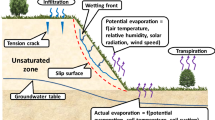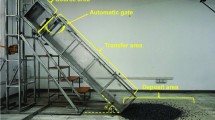Abstract
Existing underground lightning electromagnetic field predictive methods are only relevant to conductivity distributions that are homogeneous or layered. In order to expand the scope of application of lightning electromagnetic field computation, the effect of heterogeneous soil conductivity on the electromagnetic field of lightning return is examined in depth. The current distribution in the lightning return channel is characterized by the dual Heidler discharge channel base current and MTLE return model. Using the full-wave finite element approach, a two-dimensional axisymmetric model is created. The time distribution characteristics of the lightning electromagnetic field in a soil with heterogeneous conductivity are evaluated. According to the research, the lightning electromagnetic field's, horizontal electric field, vertical electric field, and azimuthal magnetic field components are negatively, bipolarly, and positively distributed in the subsurface, respectively. The horizontal electric field dominates the subterranean electromagnetic field. The high conductivity of the soil has a significant attenuation effect on the high-frequency components of the lightning electromagnetic field's three electromagnetic components. The initial response of the horizontal electric field of a nonhomogeneous soil is dependent on the conductivity at the surface of soil, followed by a gradual dependence on the conductivity in deeper soil sections. The subsurface distribution of vertical electric and azimuthal magnetic fields tend to stratify in response to a nonhomogeneous drop in soil conductivity.









Similar content being viewed by others
Abbreviations
- b :
-
Depth of nonhomogeneous change of soil conductivity
- \(\sigma_{1}\) :
-
Conductivity at the soil surface
- \(\sigma_{2}\) :
-
Conductivity at the soil bottom
- \(\lambda\) :
-
Current height decay constant
- v :
-
Return-stroke wavefront speed
- u :
-
Heaviside function
- I 0i :
-
Current peak
- \(\tau_{i1}\) :
-
Time coefficients of wave head
- \(\tau_{i2}\) :
-
Time coefficients of wave tail
- n i :
-
Current waveform steepness factor
- \(\eta_{i}\) :
-
Current peak correction factor
- Z :
-
Channel height
- L :
-
Model width
- H :
-
Total soil thickness
- h :
-
Nonhomogeneous layer thickness
- \(\sigma_{0}\) :
-
Conductivity of air and lightning return channels
- \(\varepsilon_{0}\) :
-
Relative permittivity of air and lightning return channels
- \(\varepsilon_{1}\) :
-
Relative permittivity of nonhomogeneous layer
- \(\varepsilon_{2}\) :
-
Relative permittivity of bottom soil
- \(\mu_{0}\) :
-
Relative magnetic permeability
- A :
-
Magnetic vector potential
- \(\mu_{0}^{\prime }\) :
-
Vacuum permeability
- \(\mu_{r}\) :
-
Relative permeability
- \(\varepsilon_{0}^{\prime }\) :
-
Vacuum permittivity
- \(\varepsilon_{r}\) :
-
Relative permittivity
- \(J_{s}\) :
-
Surface current density
- \(n\) :
-
Unit normal vector directed from soil to air
- \(\delta\) :
-
Channel width
- \(\Delta t\) :
-
Time steps
- \(E_{r}\) :
-
Horizontal electric field component
- \(E_{z}\) :
-
Vertical electric field component
- \(H_{\varphi }\) :
-
Azimuthal magnetic field component
References
Akbari M, Sheshyekani K, Pirayesh A et al (2013) Evaluation of lightning electromagnetic fields and their induced voltages on overhead lines considering the frequency dependence of soil electrical parameters. IEEE Trans Electromagn Compat 55(6):1210–1219
Aoki M, Baba Y, Rakov VA (2015) FDTD simulation of LEMP propagation over lossy ground: Influence of distance, ground conductivity, and source parameters. J Geophys Res Atmos 120(16):8043–8051
Chaladgarn T, Yooyuanyong S (2013) Mathematical model of magnetometric resistivity sounding for a conductive host with a bulge overburden. Appl Math Sci 7(5):335–348
Chumchob N (2004) Mathematical modelling of electromagnetic response on a multilayered earth with a layer having exponentially varying conductivity. Thai J Math 2(2):333–358
Cooray V (1992) Horizontal fields generated by return strokes. Radio Sci 27(04):529–537
Cooray V (2010) Horizontal electric field above-and underground produced by lightning flashes. IEEE Trans Electromagn Compat 52(4):936–943
Delfino F, Procopio R, Rossi M et al (2007) An algorithm for the exact evaluation of the underground lightning electromagnetic fields. IEEE Trans Electromagn Compat 49(2):401–411
Delfino F, Procopio R, Rossi M et al (2009) Influence of frequency-dependent soil electrical parameters on the evaluation of lightning electromagnetic fields in air and underground. J Geophys Res Atmos. https://doi.org/10.1029/2008JD011127
Kim HS, Lee K (1996) Response of a multilayered earth with layers having exponentially varying resistivities. Geophysics 61(1):180–191
Kurnaz O, Aksoy S (2021) Electromagnetic fields radiated by lightning return stroke over lossy ground with rock formation. IEEE Trans Electromagn Compat 63(5):1444–1451
Mimouni A, Delfino F, Procopio R et al. (2007) On the computation of underground electromagnetic fields generated by lightning: A comparison between different approaches. In 2007 IEEE Lausanne Power Tech. IEEE, pp 772–777
Mimouni A, Rachidi F, Rubinstein M (2013) Electromagnetic fields of a lightning return stroke in presence of a stratified ground. IEEE Trans Electromagn Compat 56(2):413–418
Napolitano F, Borghetti A, Nucci CA et al (2013) Use of the full-wave finite element method for the numerical electromagnetic analysis of LEMP and its coupling to overhead lines. Electric Power Syst Res 94:24–29
Nucci CA, Diendorfer G, Uman MA et al (1990) Lightning return stroke current models with specifiedchannel-base current: a review and comparison. J Geophys Res Atmos 95(D12):20395–20408
Ouyang S, Zhang QL, Li Y et al (2012) Impact on lightning electromagnetic field propagation of soil electrical parameter variation induced by varying surface soil moisture. Meteorol Sci Technol 40(06):1018–1024 (in Chinese)
Paknahad J, Sheshyekani K, Hamzeh M et al. (2014a) Lightning electromagnetic fields and their induced voltages on overhead lines: the effect of a non-flat lossy ground. In: 2014a international conference on lightning protection (ICLP). IEEE. pp 591–594
Paknahad J, Sheshyekani K, Rachidi F et al (2014b) Lightning electromagnetic fields and their induced currents on buried cables Part II The effect of a horizontally stratified ground. IEEE Trans Electromag Compat 56(5):1146–1154
Paknahad J, Sheshyekani K, Hamzeh M et al (2015) The influence of the slope angle of the ocean–land mixed propagation path on the lightning electromagnetic fields. IEEE Trans Electromagn Compat 57(5):1086–1095
Rachidi F, Janischewskyj W, Hussein AM et al (2001) Current and electromagnetic field associated with lightning return strokes to tall towers. IEEE Trans Electromagn Compat 43(3):356–367
Shoory A, Rachidi F, Delfino F et al (2011) Lightning electromagnetic radiation over a stratified conducting ground: 2. Validity of simplified approaches. J Geophys Res Atmos. https://doi.org/10.1029/2010JD015078
Sripanya W (2014) Mathematical modelling of magnetic field from heterogeneous media with a homogeneous overburden. Int J Pure Appl Math 94(1):37–44
Sripanya W, Yooyuanyong S (2012) Mathematical inverse problem of magnetic field from exponentially varying conductive ground. Appl Math Sci 6(113):5639–5647
Tunnurak P, Kanyamee N, Yooyuanyong S (2015) Finite element magnetic field response of an exponential conductivity ground profile. Appl Math Sci 9(52):2579–2594
Wang XJ, Chen YZ, Wan HJ et al (2017a) Characteristics of lightning electromagnetic fields from oblique lightning channel considering vertical stratified ground. J Electron Inf Technol 39(02):466–473 (in Chinese)
Wang XJ, Chen YZ, Wan HJ et al (2017b) The influence of horizontal layered ground conductivity on oblique discharge channel lemp em fields. Journal of Microeaves 33(02):89–96 (in Chinese)
Yang YQ, Liu YP, Liu FF et al (2021) Research on influence of different soil types and moisture on lightning electromagnetic field based on fdtd. J Trop Meteorol 37(03):348–357 (in Chinese)
Yooyuanyong S (2000) Electromagnetic response over a varying conductive ground. Songklanakarin J Sci Technol 22(4):457–466
Zhang SQ, Wu Q (2013) Distribution characteristics of lightning electromagnetic pulsed fields under the ground. Acta Physica Sinica 62(02):563–575 (in Chinese)
Zhang Y, Gu J, Zhang E (2020) Analysis of underground propagation effects of lightning electromagnetic fields in different geological environments. Int J Appl Electromagnet Mech 62(4):861–873
Acknowledgements
The Authors gratefully acknowledge the financial support for this work provided by the National Natural Science Foundation of China (No. 42077435). In addition, the authors would take this opportunity to thank the editors and the anonymous reviewers for their valuable comments and suggestions in improving this paper.
Author information
Authors and Affiliations
Corresponding author
Ethics declarations
Conflict of interest
The authors declare that they have no known competing financial interests or personal relationships that could have appeared to influence the work reported in this paper.
Additional information
Edited by Dr. Mario Zarroca Hernández (ASSOCIATE EDITOR) / Prof. Gabriela Fernández Viejo (CO-EDITOR-IN-CHIEF).
Rights and permissions
Springer Nature or its licensor (e.g. a society or other partner) holds exclusive rights to this article under a publishing agreement with the author(s) or other rightsholder(s); author self-archiving of the accepted manuscript version of this article is solely governed by the terms of such publishing agreement and applicable law.
About this article
Cite this article
Xiang, Y., Rao, P., Feng, W. et al. Evaluation of time history distribution characteristics of lightning electromagnetic field in heterogeneous soil. Acta Geophys. 72, 793–805 (2024). https://doi.org/10.1007/s11600-023-01100-w
Received:
Accepted:
Published:
Issue Date:
DOI: https://doi.org/10.1007/s11600-023-01100-w




